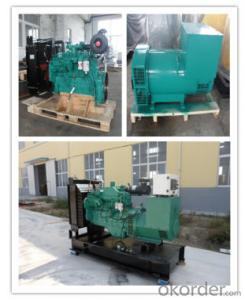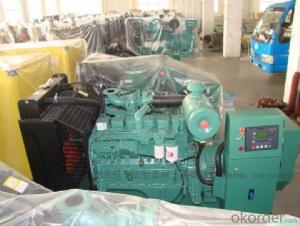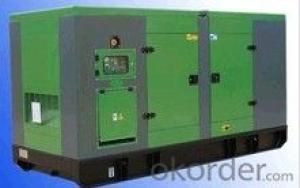Factory price china yuchai diesel generator sets 270kw
- Loading Port:
- Shanghai
- Payment Terms:
- TT OR LC
- Min Order Qty:
- 1 unit
- Supply Capability:
- 300 unit/month
OKorder Service Pledge
OKorder Financial Service
You Might Also Like
Specifications
open type dioesel generator with yuchai enginee
1) Factory direct sale
(2) CE, ISO9001 quality
Power range | 18-650KW |
Engine | All series powered by Yuchai engine |
Alternator | All series owning alternator options of Stamford/Marathon/ENGGA |
Controller system | Hanging control box, automatic control module Smartgen HGM6310 |
Base frame | International channel steel welded base, inbuilt composite damping system; sandblast, acid-washing, antiseptic treatment |
Radiator | Standard genset-joining radiator of 40 °C ambient temperature |
Diesel generator Powered by Yuchai Engine,which yuchai is a large state-owned enterprise and a Nasdaq listed company in USA (NYSE:CYD). Its main business covers diesel engine, contruction machinery, vehicle parts. The engines produced by Yuchai include series YC6G, YC4G, YC4E to which American technology applied, series YC6A, YC6B, YC6J, YC4B, YC4D, YC4F, YC4W to which German technology applied, and YC6M series in which world top technology integrated, totally 12 series.
| YUCHAI Series | Power(KW) | Power(KVA) | Jichai Engine Model | Cylinder NO. | Fuel consumption g/kw.h | DimensionL*W*H | Weight KG |
| FKS-Y280 | 280 | 200 | YC6G245L-D20 | 6 | ≤195 | 2500*970*1500 | 2300 |
- Q: I have to wonder. WHY don't we have a car right now in 2010 that gets 100+ mpg?Ok we have the Honda Insight and Toyota Prius that get 50MPG+ WELL why not DOUBLE or TRIPLE or QUADRUPLE the Batteries and get 100MPG??? Seriously WHY NOT PACK Enough Lithium Ion batteries in there to get 300MPG?? You mean to tell me that with all the technology we have today in 2010 that we can't come up with a Hybrid that gets 100MPG??? PURE NonsenseSomeone somewhere is keeping the 100MPG car from being produced. Simple as that. You mean to tell me that you can't pack enough Lithium Ion batteries into a CAR to get 100MPG??? Yea right. You know it could be done. BIG OIL and other political forces DON'T WANT the 100MPG car. Why did gas prices go to $4.50 per gallon??? TO get the $$$ While the Getting was good. Now the gig is up and they know it.
- Lithium ion batteries are a good source of energy storage, but they have some very serious drawbacks: If they are shorted they can go into melt-down and start a fire, and that's the small ones the size of a quarter. Think what could happen after a car wreck - You could start a block leveling fire. There will have to be a better battery design before the electric car becomes viable.
- Q: i think having a back up generator at my home would be useful in case of winter power disruptions however and although the new generation generators are quiet enough to stand next to where would I stand with electricity suppliers ?
- No. Running a fuel-powered motor inside any building is unsafe.
- Q: First of all let us get down to the corruption of all of this hoax created by Al Gore which is nothing but a scheme to put the public in fear. This will stop all of the money going out to create bogus programs. Next, let is realize that hybrid automobiles mpg results have been overinflated by the corrupt EPA. Since they have been caught, now they are doing real world tests. Now, let us look at what Europe is doing with automobiles. CLEAN DIESEL. These clean diesels consume far less fuel than gasoline motors of the same size. They are getting quieter, no longer smoke, and are as fast as gasoline cars in some cases. Mrs. Speaker, I challenge you to drive one of these cars and you will be surprised. However, I think the public should decide on whether Global Warming is true or not. I do not want you and a hand full of others control our lives when we vote you in there to work for us.
- I agree. This has just recently become an option as ULSD was just mandated in Nov 2006, and newer diesels manufactured recently must have stricter emissions standards and must have particulate traps on the exhaust. High NOx levels are still of some concern because of the excess heat and pressures created by the high compression in diesel engines. Also it's easier to use biofuels. You don't need a flex anything! I have 4 diesels, and I use biodiesel in all of them for 3 reasons: 1 - Reduces dependence on foreign oil 2 - Makes a diesel run better due to superior lubrication 3 - Whether global warming is true or not, I'm at least doing my part with out even doing anything different. Good call pro-diesel. Hopefully others will see the light.
- Q: Diesel trains use electric motors because the low-end torque is much greater than a mechanical drive drive train, I was wondering, since low-end torque is essential to starting with heavy dead weight, why more trucks and SUVs don't have electric motors on the wheels?
- Diesel okorder
- Q: I live in a location without municipal water supply. I could buy a natural gas generator, and hire an electrician to connect it to my breaker box, but I believe there is a way to connect solar panels to a battery system to provide enough power for my 220 volts submerged pump. I have 2 horses, 24 chickens, 2 dogs, 4 cats, 3 parakeets, and 3 people that need water in the event of a hurricane, national power grid attack,etc. There are solar powered generators advertised, but they are not powerful enough for 220. Also, my whole neighborhood of over 200 homes all lives off their own water wells, and we all suffered during hurricane Ike: 10 days without a water supply.
- For solar you would want to have a bank of batteries to store that power. Like the other guy said, you're better off buying a Honda Generator or even just a diesel (not gasoline, DIESEL) powered pump for emergencies.
- Q: If the electrical grid fails and takes years to re-establish, how will the plants cool down?
- Homemade okorder
- Q: I have been given a cheap diesel generator made from china. It starts alright, but seems to be reving very high and poping and spitting until it has ran for a while. It surges some times as well. I don't really like it much and haven't used it to power anything other then to load test it a bit. I have checked the motor and all it has is a simple governor on it with no adjustments? I am not sure even where to start adjusting anything on this. Any body have one of these and same problem? Please I was given it, I would like to get a little service out of it , not just junk it Fuel, oil, air filter are all new.so? help?
- So what did you want to do with this engine? It sounds like a stationary engine used to power a generator or pump or similar application at a constant RPM.
- Q: i understand that diesel engines are used in heavy duty vehicles and gasolines are usually used in cars.why are diesel engines preferred for heavy duty? and who are some cars using diesel engine, like some VW models that use clean diesel.i know the engine works a bit different between diesel and gasoline but as for performance, why is one preferred over the other for heavy duty and regular cars?
- a diesel engine develops so much more torque compared to a spark ignition engine. given that the typical engine has a compression ratio of about 12:1 MAX and a diesel is roughly 18 to 22:1, when you ignite the air fuel charge by any means that compressed gas is what does every thing, in a spark ignition engine that air charge expands to 4 times its volume. i do not have a diesels ratio but there can not be much of a difference. that 12 to 1 now be comes 48 to one in a very small area forcing that piston to move. in the diesel with a 20 to one compression ratio, now 80 to one putting an immense force on the face of that piston. so muck torque is developed. i have no info on the clean diesels, so i will stop, but diesels are known for the smoke in the exhaust whick is particulate matter in the air that will settle out.
- Q: I need a flowchart of the endergy conversions while popping popcorn. Example: Chemical energy to physical energy to nuclear energy, etc.
- Starting from the pop and moving towards the energy source The kinetic energy of the popped kernel converting to heat when the kernel comes to rest. The kinetic energy of the kernel from the explosion due to steam and the steam escapes with kinetic and heat energy that transfers to the ambient air as the steam condenses and then the droplets fall and convert kinetic energy to heat. Potential energy in the steam as it builds pressure inside the kernel The transfer of heat from the burner into the popping vessel to raise the temperature of the moisture inside the kernel to make steam Where did the energy come from to heat the burner? I will assume it is electrical energy created from a diesel generator peaker plant nearby There is resistance in the burner heating element that converts the electric current to heat. There is also resistance in the wires and transmission lines and transformers that carry the electricity from the power plant to the burner, which is all lost to heat. The electricity is created from a generator where there is an wire-wound aperture spinning in the presence of a magnetic field. The kinetic energy of the aperture gets converted to the electrical energy and sent out on the transmission lines. The kinetic energy of the aperture is created inside a diesel engine by connecting it to the crank shaft - some friction losses due to bearing surfaces. The kinetic energy of the crank shaft is created from an explosion inside a piston. The explosion creates an expansion of gases that push the piston, which spins the crank shaft. Some of this energy is lost to heat dissipatin and friction. The explosion was from the conversion of the chemical energy in the diesel fuel to heat. The pressure in the piston caused the fuel and oxygen mixture to explode. How's that? j
- Q: How much is the waste of the power that may be lost in the combination of two engine and where I can find the diagram that shows the relation between rpm and HP in the combined two diesel engine.this two engine combined with a clutch that synchronize two engine for two input in gears and single output.
- It's best to connect them at the crank so that they can be timed to fire in a manner that your getting the most amount of power you can. This has been done in applications as small as a .12cc engine all the way up to huge engines that power large ships. The most common place I used to see it is with gas engines for tractor pull. The engines do sync up and will run together when you pair them up thru a clutch
Send your message to us
Factory price china yuchai diesel generator sets 270kw
- Loading Port:
- Shanghai
- Payment Terms:
- TT OR LC
- Min Order Qty:
- 1 unit
- Supply Capability:
- 300 unit/month
OKorder Service Pledge
OKorder Financial Service
Similar products
Hot products
Hot Searches
























